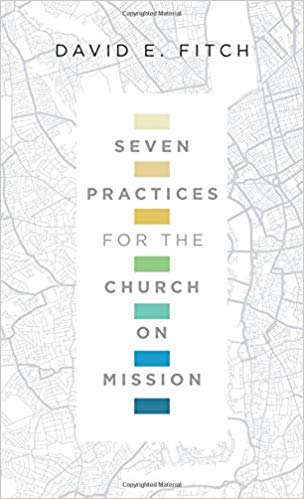Book Review: Seven Practices for the Church on Mission, by David Fitch
December 27, 2018

December 27, 2018
David E. Fitch, Seven Practices for the Church on Mission. IVP Books, 2018. 141 pages, $12.00.
David Fitch’s most recent publication, Seven Practices for the Church on Mission (a simplified version of his earlier book Faithful Presence), argues that “presence is the way God works. Through his presence, he is bringing the whole world to himself” (1). As a result, “our task . . . as Christians could be summarized in one short sentence: Be present to his presence. In all our relationships, let us discern his presence and cooperate with what he is doing” (1).
Fitch unpacks seven practices for discerning the presence of God: the Lord’s Table, reconciliation, proclaiming the gospel, being with the ‘least of these,’ being with children, the fivefold gifting, and kingdom prayer. Finally, he identifies the three spheres where we should tend to the presence of God: in a close circle (mainly the church gathered), in a dotted circle (Christians with their neighbors), and in a half circle (Christians among the hurting and the outcasts).
Fitch’s emphasis on the presence of God being manifested among and through his people is a refreshing and intriguing theme that is not often explored in evangelical circles. I think that Peter (Luke 5:8) and Moses (Exodus 3) would agree with Fitch when he argues that “[God’s] presence always brings the reordering of our lives together into his kingdom.” (7). Fitch also rightly laments how flippantly some evangelical churches treat the Lord’s Supper when he says, “many churches practice the Lord’s Table as a mere remembrance for a few short minutes after a Sunday morning service. We’ve lost the social reality that binds us together into the presence of Christ” (22).
Despite these strengths, Fitch displays a cavalier attitude toward Scripture which leaves the reader with little confidence that his ministry paradigm is biblical. First, Fitch curiously uses the following verbs to describe the believer’s relationship to the presence of God: be present to, open space for, discern, tend to, submit to, sense, and pray for sensitivity to. Yet, he never provides any biblical argument or precedent for relating to God’s presence in these ways. What does ‘tending to’ the presence of Christ really mean? A survey of Scripture quickly reveals that believers should rather tremble (Ps. 114:7), shout for joy and fall facedown (Lev. 9:24), serve (Deut. 18:7), enter into (Exod. 28:30), pour out your heart (Lam. 2:19), worship (Ezek. 46:3), and finally know and/or believe (Matt. 28:20) in God’s presence. Fitch’s concept of God’s presence is highly subjective, feelings-oriented, and portrays God as passive.
Second, Fitch described how Jesus gave his disciples seven practices for opening space for his presence. These seven practices, however, are highly arbitrary. For example, Fitch included ‘being with children’ on this list. While it is indisputable that Jesus welcomed children in Matthew 18:4, Jesus’ main point is to uphold the humility of children as a chief characteristic of those who will be the greatest in the kingdom of heaven. Additionally, we do not have one biblical example of the early church seeking the presence of God through ‘being with children.’ In contrast, the practice of driving out demons is practiced far more often, and is linked to the coming kingdom (Matt 12:28), yet is not included.
Fitch also advocates for a concept of mutuality which he contrasts with any notion of authority (99-100). He rejects any type of strong leadership which exercises authority over others. According to Fitch, in Ephesians 6:4 Paul “calls parent and child into a space of mutuality in the Lord. The parent is not singularly over the child” (87). Fitch never succeeds in clearly defining how authority and mutuality interact, and how mutuality and equality differ (if at all). While I can appreciate how the author emphasizes the biblical precedent of the servant-leader working for the best interests of those under him or her, I am concerned that any type of bold leadership (i.e. Paul rebuking Peter in Galatians) would be regarded by Fitch as the product of a worldly, hierarchical system that governs with a heavy hand (101).
Finally, Fitch most poignantly evidences his cavalier approach to Scripture as he describes the Lord’s Supper. “The Lord’s Table happens every time we share a meal together with people and tend to the presence of Christ among us. Granted the formal Lord’s Table only happens at the close table. But that table extends from there. The table is never merely in here or out there. It is the continual lived space with and among the world” (20). He goes on to claim that Jesus feeding the five thousand (Mark 6) and sending out the seventy-two (Luke 10) are considered Lord’s Table activities. He supports this notion by asserting that these passages also include a meal and the verbs “take,” “bless,” “break,” and “give” (13). While these passages all include food and believers, it is irresponsible to label these as Lord’s Table activities.
Fitch’s emphasis on the presence of God as part of our conception of the nature of the church and a philosophy of ministry does have some benefit. But his development of these ideas lacks Scriptural substance and as a result his ministry proposals are rather weak.